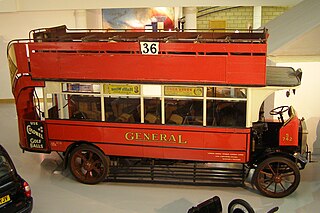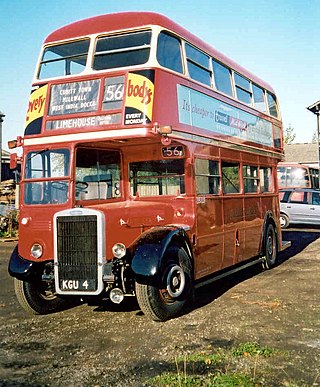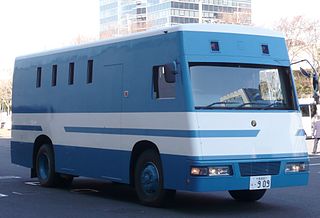
A bus is a road vehicle that carries significantly more passengers than an average car or van, but less than the average rail transport. It is most commonly used in public transport, but is also in use for charter purposes, or through private ownership. Although the average bus carries between 30 and 100 passengers, some buses have a capacity of up to 300 passengers. The most common type is the single-deck rigid bus, with double-decker and articulated buses carrying larger loads, and midibuses and minibuses carrying smaller loads. Coaches are used for longer-distance services. Many types of buses, such as city transit buses and inter-city coaches, charge a fare. Other types, such as elementary or secondary school buses or shuttle buses within a post-secondary education campus, are free. In many jurisdictions, bus drivers require a special large vehicle licence above and beyond a regular driving licence.

Buses have been used as a mode of public transport in London since 1829, when George Shillibeer started operating a horse-drawn omnibus service from Paddington to the City of London. In the decades since their introduction, the red London bus has become a symbol of the city.

Associated Equipment Company (AEC) was a British vehicle manufacturer that built buses, motorcoaches and trucks from 1912 until 1979. The name Associated Equipment Company was hardly ever used; instead, it traded under the AEC and ACLO brands. During World War One, AEC was the most prolific British lorry manufacturer, after building London's buses before the war.

The London General Omnibus Company or LGOC, was the principal bus operator in London between 1855 and 1933. It was also, for a short period between 1909 and 1912, a motor bus manufacturer.

The Leyland Titan was a forward-control chassis with a front-mounted engine designed to carry double-decker bus bodywork. It was built mainly for the United Kingdom market between 1927 and 1942, and between 1945 and 1969.

Guy Motors was a Wolverhampton-based vehicle manufacturer that produced cars, lorries, buses and trolleybuses. The company was founded by Sydney S. Guy (1885–1971) who was born in Kings Heath, Birmingham. Guy Motors operated out of its Fallings Park factory from 1914 to 1982, playing an important role in the development of the British motor industry.
The LGOC X-type is an early model of London double-decker bus.

The AEC Q-type is an AEC-built, side-mounted-engine, single- and double-decker bus that was launched in 1932.

The AEC Regent III RT was one of the variants of the AEC Regent III. It was a double-decker bus produced jointly between AEC and London Transport. It was the standard red London bus in the 1950s and continued to outnumber the better-known Routemaster throughout the 1960s.

The AEC Regent II was a front-engined double-decker bus built by AEC from 1945 to 1947. Despite officially being a new type it was very similar to the 1929 Regent. The Regent IIs were all documented as being new with the A173 engine and a four speed sliding mesh gearbox. The only vehicles that were not standard were the 100 purchased by B.M.M.O., which were classified as O661/20 as the front had to be re-designed so they could carry similar bonnets and radiator grilles that B.M.M.O. had designed for the double deckers they built themselves.

Aldershot & District Traction Company Limited was a major bus company operating services in East Hampshire, West Surrey and parts of adjoining counties for sixty years during the 20th century, from 1912 until 1972 when it became part of Alder Valley.

Green Line is a long standing commuter coach brand in the Home counties of England. The trademark is owned by Arriva, with services operated by Arriva Herts & Essex.

The AEC K-type was a type of bus chassis built by Associated Equipment Company (AEC) from 1919 until 1926, mainly for use in London by the London General Omnibus Company (LGOC).

An armoured bus or armored bus is a type of bus which provides increased protection for passengers, usually against small arms and improvised explosive devices. The bus can be a stock commercial bus with retro-fitted vehicle armour as well as bulletproof glass, or a specially built military armoured vehicle. Lighter armoured buses are also used for prisoner transport.

Old Bill is a fictional character created in 1914–15 by cartoonist Bruce Bairnsfather. Old Bill was depicted as an elderly, pipe-smoking British "tommy" with a walrus moustache. The character achieved a great deal of popularity during World War I where it was considered a major morale booster for the British troops. Old Bill and his younger troopmate little Alphie were private infantrymen in the British Expeditionary Force.

The Tilling Group was one of two conglomerates that controlled almost all of the major bus operators in the United Kingdom between World Wars I and II and until nationalisation in 1948.

In common with cars and trucks, preservation of buses in the United Kingdom is a hobby activity enjoyed by many people, both actively or passively. The active preservation and operation of preserved buses is undertaken by private individuals, organised trusts or societies, and even commercial operators. The preserved bus fleet in the UK includes dating from the earliest pre-war models right up to models manufactured after the year 2000.
Frank Searle CBE, DSO, MIME was a British transport entrepreneur, a locomotive engineer who moved from steam to omnibuses, the motor industry and airlines.
The AEC Renown was the name given to three distinct forward control bus chassis manufactured by the Associated Equipment Company (AEC) at different periods between 1925 and 1967. All were of the front-engine, rear-wheel-drive layout. The first and third types had two axles, the second had three. Each was intended to be fitted with bodywork by an outside coachbuilder – single deck for the first type, double deck for the third, whilst the second could be bodied in either form.

The AEC Regent I was a double-decker bus chassis manufactured by AEC.





















